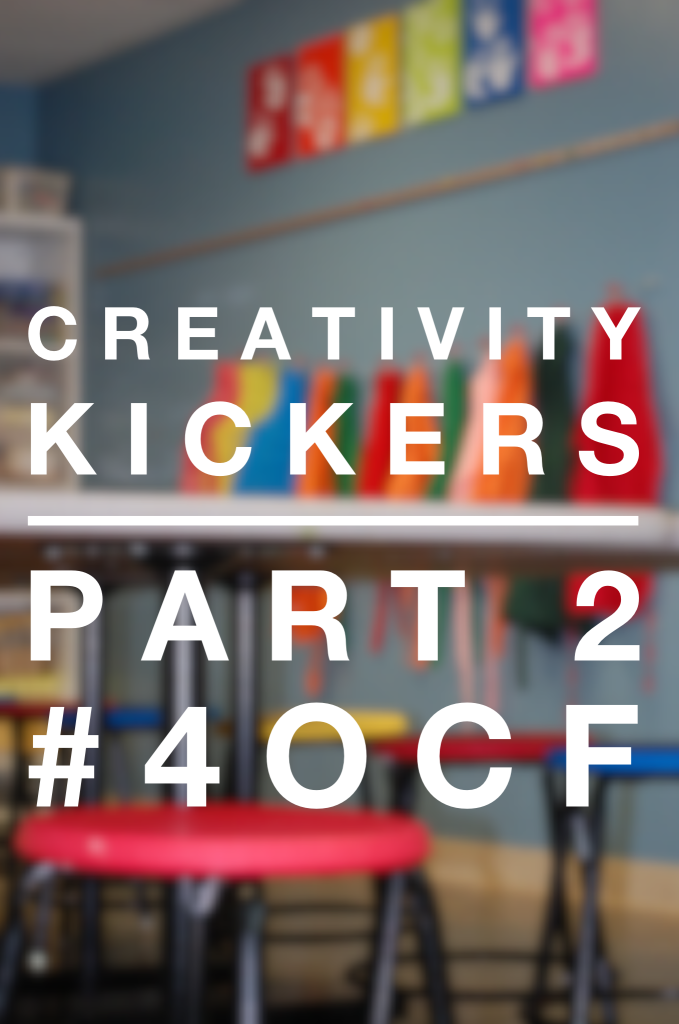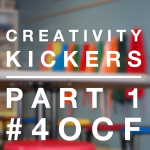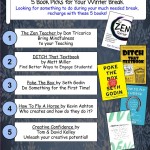A Guest Blog Post by Jeanne Muzi
Need some new ideas for CREATIVITY KICKERS:
Below are more 10 quick and easy activities (Click here for Part 1) that you can add to your Cultivating Creativity Tool Belt so your elementary students have more opportunities to build creative thinking skills. These activities can be completed in pockets of 5, 10, 15 or 30 minutes with little prep and can be incorporated with or without technology integration:
- Construction Challenges: Distribute a limited amount of materials (Lego bricks, popsicle sticks, index cards, etc.) to student groups along with a challenge (design a bridge, build a tower that can hold a weight, etc.). Students brainstorm, design, build, revise & problem solve.
- Student Mini-Musicals: Create cards and students pick one as independent or partner work. Some examples: Tell the lifecycle of a butterfly using the tune of Old MacDonald had a Farm, Explain the parts of a weather station using the tune of the song B-I-N-G-O!, Define five 3-dimensional shapes to the tune of Row, Row, Row, Your Boat! Ask students to suggest tasks and songs that would work well for mini-musicals. Sing the songs for the class or film them and keep an album of songs on an iPad or computer. Great opportunity to partner and connect to the music teacher.
- Lit Raps: Student groups can create raps about the books they are reading. First, students must list 10 words from the story that are most important, things like characters’ names, settings, problems and solutions. Second, students must list 10 words that rhyme. They will then work on a white board, combining key book words with rhyming words to create phrases for their raps, revising and editing as needed. When each group performs their rap, they can recommend the book, add information about the author or design a logo to go with the rap. Film the raps or collect a selection of them for a podcast or keep a collection of raps on an iPad or computer so students can re-visit or share with a wider audience.
- Musical themes: Students compose class songs, sing introductions to subjects or units and create group cheers. Highlight patterning and math thinking as students work. Brain connections are strengthened as students teach each other their compositions (they can also add movement and choreography).
- Would you rather be a _______ or a _____________? Create your own cards (with student input) and select a card to answer and discuss each day. Some ideas to start you out: Would you rather play indoors or out? Be a pirate or a clown? Have it always summer or always winter? Be a fish or a bird? Would you rather bounce on a trampoline or ride a unicycle? Would you rather have a dog or a cat? Would you rather go to the doctor or the dentist? Would you rather be a shark or an octopus? Would you rather be blue or green? Partner groups can then create their own cards and share them with other groups.
- Character in Search of a Setting: Make multiple photocopies of book characters that are familiar to your students (Clifford, Cat in the Hat, Franklin, Henry and Mudge, Jack and Annie, etc.). Cut out just the character (no background) and put the copies in an envelope. Students will select one character copy and glue it to a blank piece of paper. The student will then illustrate the setting they would like to see their character in, adding lots of interesting detail. The student can then turn the paper over and write about the setting/story they created (note: this can also be done with copies of non-fiction animals/insects/dinosaurs. Students can add habitats and write facts on the back).
- Evidence Please!: Students work as partners to discover evidence from non-book complex “texts.” Objects can include photographs, artwork, newspaper articles, cartoons, poems, advertisements, commercials, etc. Pull up various images on classroom devices for small groups, individuals or as a whole class introduction. Students will stand and make a statement about their item and present supporting evidence for their assertion.
- Museum Exhibition Team: Students work together to select 6 different pictures (art prints, illustrations or non-fiction items- materials can be connected to subject content or just a sampling of different items- Items can be photos/pictures the students handle or digital collections students can manipulate) they think go together and should be hung in a museum exhibit. They must give reasons for putting these particular images together. Write the following questions on cards. Laminate and put the questions in an envelope (or keep them in a doc file). Place the envelope with the selection of pictures. Students take turns asking, answering and discussing the questions. Questions: What do you see? What is happening in this picture? Who is in this picture? What color do you notice first? What geometric shapes do you see? How does this picture make you feel? What is the first thing you think of when you look at this picture? Does this picture remind you of someone you know or a place you have been? Does this picture remind you of another picture you have seen? Does this picture tell a story? Does the background have different colors than the foreground or are they pretty much the same? What is the mood of this picture? Is it happy, sad, scary, funny, peaceful? Why do you think this picture was made? Can you find some very interesting details in this picture that you may not see right away? Should this be placed in the exhibit? Why or Why not? Students present their exhibitions to their groups or as a gallery walk.
- Expert Panels: Divide the class in groups and ask each group to delve deeply into something (for example if you are studying Weather, one group will research clouds, another- storms, another- meteorology). When ready, each group will sit as a panel of experts and share their facts, information and knowledge. They will take questions and then the panels with rotate (Students teaching students).
- Brain Breaks Cup: Write a selection of energizers on Popsicle sticks or cards (or use the random generator in Smart Notebook) and select one when a break is needed to pump some oxygen into the brains of your students (this can include going on sites like GoNoodle and Kahoot). Some ideas include: 1 minute Yoga Pose, Three Tic Tac Toe Games, Mirror Your Partners Actions (each get one minute), Sky Writing Words of the Week (follow the leader on this), Silent Air Band-Select your instrument and rock out for 2 minutes without a sound!, One Minute Stretch-a-thon, One Minute Jogging trail-Stay in place but listen as the leader describes the hills, valleys, curves, rocks, etc., Calendar Jumping Jacks- Leader picks three numbers from the calendar and the class does that number of jumping jacks, with a 20 second rest between, 5 Minute Doodle- Students get a piece of scrap paper and doodle while music plays, Humming Conga Line- Students go around the room in a conga line two or three times while humming a class song, cheer or rap. Those are a few ideas to get you started- Now make up your own with your kids.
These are quick and simple ways to build bursts of creativity into the routines, procedures and periods of your day. As students learn and practice these kinds of activities, they strengthen their ability to question and think through their ideas. Students who regularly practice creative thinking things are more open to unique approaches and novel ways to solve problems.
Click here in case you missed Part 1 with 10 other quick and easy activities!
By Jeanne Muzi (@MuziLearningLab)
Jeanne Muzi is the Elementary Enrichment Specialist/Gifted Education Teacher at Lawrence Township Public Schools in Lawrenceville, NJ. Her focus is on project based learning, higher order questioning and helping students develop creative problem solving skills. A former NJ State Teacher of the Year and NOAA Teacher at Sea, Jeanne has presented a wide range of workshops and professional learning experiences at schools, conferences, forums and conventions.





Pingback: Creativity Kickers Part 1 |